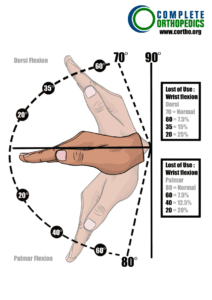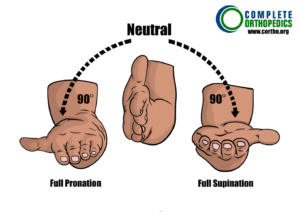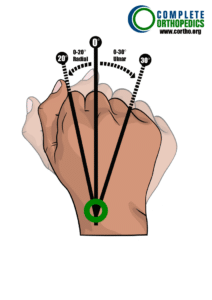If you’ve experienced an injury on the job and are curious about the implications of “Scheduled Loss of Use” (SLU) for your hand and wrist, you’re in the right place! You might qualify for a compensation payout calculated based on the guidelines set by the Workers’ Compensation Board.
You might qualify for a compensation payout calculated based on the guidelines set by the Workers’ Compensation Board.Our report will indicate that due to the accident at your workplace, you have experienced permanent impairment in the affected body part, resulting in a lasting loss of function.
Our report adheres to the Workers’ Compensation Guidelines for assessing impairment.The content of this article is derived from the guidelines outlined in the New York State workers’ compensation regulations.
We will elaborate on the process through which we assess your Scheduled Loss of Use (SLU) status for your hand and wrist.
Goals for Assessing Impairment in the Hand and Wrist

Dorsi flexion and Palmar flexion of the Wrist (Percent Loss of Use of the Hand)


Determining the Degree of Impairment
The assessment of the wrist’s schedule loss of function begins with the evaluation of any unusual circumstances.
If there are no such considerations, the total schedule loss of wrist usage is calculated by adding the deficits in Palmar Flexion, Dorsi Flexion, and Pronation/Supination. However, the schedule loss of use cannot exceed 55% in the presence of clear limitations in all wrist motions
This process is part of the Workers’ Compensation system and is used to determine the compensation for the permanent loss of earning power resulting from a permanent functional impairment
The assessment of the percentage loss of use of the wrist involves adding the deficits in specific ranges of motion, such as Palmar Flexion (A), Dorsi Flexion (B), and Pronation/Supination (C). The total value should not exceed 55%, and the percentages should be adjusted proportionally for motion values above or below those depicted. Special considerations and factors are also taken into account when determining the schedule loss of use for the wrist

When a single deficit is present, a lower percentage is used, and a higher percentage is used when both deficits are affected.Individuals receive monetary compensation for the permanent functional impairment of the wrist, which affects their ability to earn a living.
The compensation is based on the specific part of the wrist affected and the type of permanent disability. For instance, complete loss of Palmar flexion results in a 25% loss of the hand, complete loss of Dorsi flexion results in a 33⅓% loss of the hand, and complete loss of both pronation and supination results in a 35% loss of use of the hand. Deficits in radial-lateral motion and ulnar motion may be separately considered if other findings in the wrist are normal
We use the following Special Considerations
We take specific factors into account when determining schedule loss of use figures. If there’s a deficit indicated or no schedule value is provided, additional deficits may be introduced. Except for Special Consideration Number One below, the Maximum Schedule Loss of Use Value cannot exceed the Value of Ankylosis.
Complete wrist drop, also called radial nerve palsy, leads to a 66 ⅔% loss of hand function; partial wrist drop results in a lower percentage.
The Darrach procedure (distal ulna resection) results in a 10% reduction in hand function due to bone loss and mobility issues.
Resection of the “proximal row” carpal bones results in a 20% reduction in hand function due to bone loss alone, plus any associated mobility issues.
Hold non-union cases for two years for Navicular fracture. If X-rays show signs of clinical union (fibrous) and pain is not severe, schedule loss of hand function. Consider classification for unusually painful situations.
Hold until X-rays indicate a static situation for Kienböck’s disease (aseptic necrosis of the carpal lunate). Consider classification if symptomatic.
For Carpal Tunnel Syndrome: If asymptomatic, schedule one-year post decompression. Consider classification if symptoms persist and become severe and incapacitating.
Depending on limitations, De Quervain’s disease causes a 7½-20% loss of thumb function with or without surgical release. Provide a schedule for loss of hand usage if there’s a residual deficit in the wrist and grip strength in the hand is compromised.
Depending on medical findings, the wrist ganglion might range from 0-7½% of the hand
Amputation
Experiencing one of the most severe workplace injuries, amputation leaves lasting impacts on a worker’s life and well-being. In situations where the injury impedes the natural healing of damaged bone or tissue, surgical amputation might become necessary.
The decision to amputate a compromised limb arises when it can no longer receive the vital blood supply containing oxygen and nutrients, causing cells to deteriorate gradually and lose function.
Medical professionals always consider amputation as the last resort due to the physical trauma it inflicts on the body and the potential impact on the claimant’s mental health. Post-surgery, an amputee may need months of therapy and may develop post-traumatic stress disorder.
The consequences could mean an inability to sustain a livelihood after the accident or earning less. Any form of amputation inevitably alters the patient’s quality of life permanently.
Wrist amputation, for instance, leads to a complete loss of hand function (80 percent loss of use of the arm).
For more detailed information, please consult the Workers Compensation Board website of your state or seek advice from your Workers Compensation attorney.




